A History of HMS EMPRESS
|
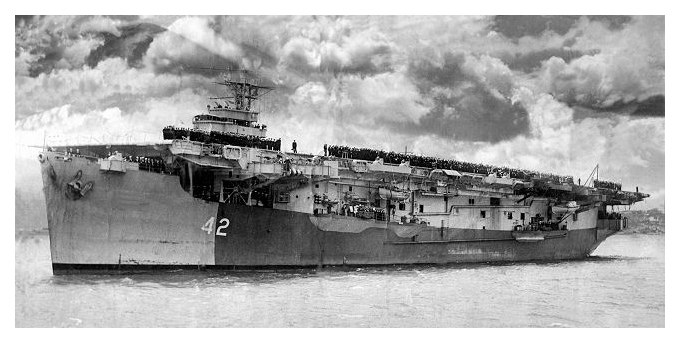 |
HMS EMPRESS approaching her mooring at Wellington, New
Zealand, November 3rd 1945. Photo: Courtesy of Ross
McGregor |
HMS EMPRESS was a ‘Ruler’ class escort carrier, her keel was laid down September 9th 1942 at Seattle-Tacoma Shipbuilding Co. Tacoma, Washington, a Maritime Commission C3 type freighter hull number 249, Seattle-Tacoma hull number 33; the hull was purchased by the US navy to become the auxiliary aircraft carrier USS CARNEGIE ACV-38, a 'Prince William' class escort carrier. She was launched on December 30th 1942. Whilst still under construction it had been decided that CVE 38 was to be transferred to the Admiralty on loan on her completion as an aircraft carrier.
Upon her delivery on August 9th 1943 she was accepted on behalf of the US Navy by Captain J. L. McGuigan, USN Supervisor of Shipbuilding at Tacoma. The following day CVE-38 sailed for Vancouver Island, British Colombia where she berthed at berth No 8 at LaPointe Pier August 12th and was transferred to the Royal Navy on arrival. She was accepted on behalf of the Admiralty by Commander T. K. Masterman RN, as acting commanding officer and commissioned into RN service as HMS EMPRESS (Pennant number D42).
Modification and preparation to enter service:
At the time of her arrival in Vancouver it was unclear whether she would enter the yard for her modification work; due to a shortage of merchant shipping there had a shortfall in Lend-Lease aircraft deliveries from the US to India had developed and the Admiralty proposed that three of the newly completed CVEs should be employed in the ferry role rather than become fully operational. EMPRESS (CVE 38),
PATROLLER (CVE 44) and
RANEE (CVE 46) were earmarked for this duty, EMPRESS was to begin ferry operations as soon as possible, while
PATROLLER would follow in November and
RANEE in December. This planning was later amended, with
THANE (CVE 48) replacing EMPRESS. This may have been due to the fact that EMPRESS was fully operational upon leaving the Seattle-Tacoma shipyard and would be required for combat operations.
EMPRESS was the fourth of nineteen escort carriers to be modified by the Burrard
Dry Dock Co. Ltd., North Vancouver, to meet Admiralty requirements.
While in Vancouver she was to receive her full crew complement and
work-up ready for active service. Alteration work started on August
30th and as the work progressed the ship moved to other berths for
different phases of the work. She moved to No 3 berth on September
23rd and to no. 4 berth on October 3rd. While at No. 4 berth her Low
pressure turbine rotor on the 10th for remedial work which required
the component to be returned to its manufacturer. EMPRESS was moved
to No 5 berth on Oct 17th and a replacement LP rotor was received
(originally from CVE 41-
NABOB) on November 9th and work began installing this before the ship entered Burrards floating dry dock on the 16th. EMPRESS spent three days in the dry dock before returning to No 8 berth after undocking on the 19th.
During November many key members of the ship's crew arrived including her commanding officer Captain H. A. Traill RN, Commander Mastermann assuming the position of executive officer. Her alterations were completed in a total of 99 days, work being finished on December 6th. On December 9th she left the LaPointe Pier site and was moved to the Burrards terminal where she was to load stores and prepare for sea. On December 27th EMPRESS was moved to a mooring in the pool before finally emerging from the Burrards works on January 13th 1944 when she was moored in the harbour inlet and began preparing for her post modification shakedown. Her modifications had taken a total of 99 days to complete.
The next month was spent on trials and working up, for steaming, gunnery, radar and other trials and exercises in the Straits of Georgia (between Vancouver Island and the Pacific coast of British Columbia). On January 20th she began a day of flight operations with Avengers from 850 Naval Air Squadron conducting deck landing training; the aircraft flying out to the ship from RCAF
Station Sea Island. The squadron had formed and worked up at
USNAS Squantum
on the US east coast with to work up with 12 Avengers for service with EMPRESS. They arrived at the RCAF station Sea Island on December 12th to work up and join the ship at Vancouver.
At the end of January she made short round trip voyage to the US Naval Yard at Bremerton, Washington to ammunition the ship, arriving there on the 29th and on the 31st. . After a short visit to Esquimalt, Victoria, North Vancouver, to embark Confidential Books and more stores EMPRESS returned to the Stream off Lapointe Pier for the final time. The aircraft of 850 Sqn embarked again on February 17th when EMPRESS departed from Vancouver bound for the UK, via Norfolk, and New York. While embarking in Avenger FN936 ('4B') Sub-Lt G. G. Hunkin, RNVR drifted to port on landing and the Port wheel went into walkway resulting in damage to the port wing and prop.
|
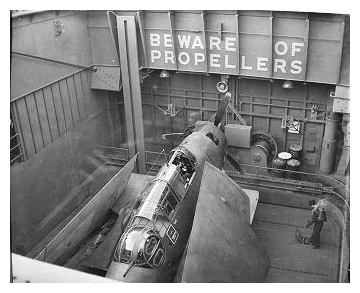 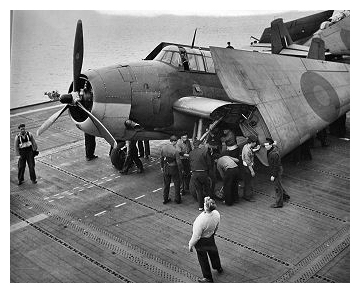 |
Avenger aircraft being raised from the hanger and
positioned on the flight deck ready for operations on.
HMS EMPRESS |
Maiden voyage: Ferry trip to UK, March 17th - April 8th 1944
On the 21st of February EMPRESS rendezvoused with sister CVE
NABOB off San Diego; the two ships were to proceed to Norfolk together, but EMPRESS had stripped a turbine and could not continue without repairs; NABOB was instructed to proceed to Balboa alone while EMPRESS arrived at the Naval Operating base San Diego at 12:23 on the 23rd for repair work to be carried out. She put to sea on the 29th to conduct a post repair shake-down and conduct flying exercises; there were two barrier crashes during the day’s flying, JZ120 flown by Sub-Lt G. Goodchild, RNVR made a fast approach, caught No.7 wire but entered the barrier, and Sub-Lt D. R. Whitehead, RNVR put JZ153 into the barrier. On completion of flying operations she rendezvoused with the American CVE the USS TULAGI and her escorts at 19:50 for passage the Panama Canal.
The two Carriers reached Balboa early on the 9th and passed through the Canal later that morning. On reaching Cristobal on the Atlantic side she met up with her sister CVE
SPEAKER. It was decided that these ships would form a small convoy consisting of three CVEs, EMPRESS,
SPEAKER, and TULAGI in company with Canadian Corvettes VANCOUVER and DAWSON, American Destroyers USS MAGI (senior and group commander), USS FROST and USS HAINES proceeded to Norfolk on March 11th. While on rout to Norfolk one of 850 squadron's Avengers operated with
SPEAKER giving the ship's flight deck parties and air department their first experience of deck landings and take-offs. Flight operations began at 12:30 on the 14th and continued throughout the afternoon.
EMPRESS suffered more engine trouble on the afternoon of the 16th, she hove to at 15:45 to make repairs; the USS FROST remained as her screen. Repairs were completed by 16:22. The small convoy arrived at Norfolk on March 18th. Here both EMPRESS and
SPEAKER received voyage repairs in the Naval Dockyard. EMPRESS then moved to the Naval Operating Base at Norfolk to embark a ferry load of lend-lease American aircraft for delivery to the UK; 850 squadron aircraft were stowed in the hangar and would not be operational during the voyage to the UK.
EMPRESS sailed for New York on the afternoon of March 25th, a day after
SPEAKER; on arrival on the 26th she secured alongside at the 35th Street pier, Brooklyn were workers from the Bethlehem steel Company to carry out voyage repairs. She now embarked more stores and equipment plus passengers for the UK; amongst these were a party of more than 50 women and children evacuees who spent part of the war in America to avoid the bombing of major British cities. Amongst this party were Davinia and Simon Bowes-Lyon, the niece and nephew of the Queen.
The
repair work was completed on the morning of March 28th when she re-joined
SPEAKER to sail with the Liverpool bound convoy CU.19 which departed New York later that day.
SPEAKER was also carrying a full ferry load of aircraft which she had collected in New York.
On reaching the Irish coast the two Carriers detached from the convoy,
SPEAKER for Liverpool, l EMPRESS for Greenock, arriving on April 8th. Here her ferry load was disembarked at Glasgow; the Avengers of 850 squadron departed on the 10th bound for RNAS Lee-on-Solent.
Deck Landing Training Duties and further modifications: April 11th - November 27th 1944
On April 11th EMPRESS was officially allocated to the strength of Western Approaches Command and was initially employed for Deck Landing Training operating with aircraft from 768 Squadron based at
RNAS Abbotsinch. Aircraft would fly out to the ship for their DLT session, returning ashore on completion. It is unclear how long she conducted DLT duties; there is only one recorded DLT incident during this period, Martlet FN196 flown by Sub-Lt T. C. Hornsey, RNVR missed all the arrester wires and entered the barrier on April 18th.
On completion of DLT duties EMPRESS was placed in the hands of a Clyde dockyard for defect rectification and later moved to Rosyth Dockyard for further modification. The dockyard works were to take until late August to complete, the ship sailed from Rosyth to return to Greenock on August 30th to prepare for another tour of duty as the west coast Deck Landing Training Carrier.
From September 6th to October 13th 1944 EMPRESS operated with pupils from 768 Squadron, now based at
RNAS Ayr. During November she carried out night DLT sessions with Swordfish from 766 Squadron from
RNAS Inskip followed by night and day DLT for the Fireflies of 1772 Squadron from
RNAS Burscough between November 25th and 27th. Once the DLT sessions were completed a series of exercises were flown for the benefit of the ship's Fighter Direction Team.
During these DLT sessions there were four accidents, two incidents involved Sub-Lt A. D. Kineham, RNVR of 766 Sqn; on the 14th flying Swordfish NF216 he bounced on landing and port wheel slipped into port walkway, on the 17th flying in LS423 he struck the rounddown with the tail damaging several longerons. On the 25th Sub-Lt I. T. O' Driscoll, RNVR in Firefly Z2022 entered the barrier after the arrester hook bounced and missed all the wires, the following day Mid R. P. Hubble, RNVR in Firefly Z1984 caught No.8 wire and tipped the barrier.
Allocated to East Indies Fleet for operations with 21st Aircraft Carrier Squadron
Her flying training duties at an end HMS EMPRESS proceeded to Devonport, arriving there just before Christmas. Leave was granted to both watches. An ENSA party gave performances on a stage built in the hangar for those remaining on board and guests from other ships in the dockyard. Towards the end of December work began storing and equipping the ship for operations with the East Indies Fleet.
At the beginning of January 1945 EMPRESS began loading Hellcat fighters into the hangar and flight deck to be transported to India after which she was to join the East Indies Fleet based in Trincomalee in Ceylon.
EMPRESS was to complete the first leg of her voyage in company with convoy KMF 38 which sailed from the Clyde on January 5th and arrived at Gibraltar on the 10th. After refuelling at Gibraltar the ship made a solo passage to Port Said and passage through the Suez Canal. From Port Tewfik she preceded directly to Cochin in Southern India were her ferry load was disembarked
to
RNAS Cochin. She next sailed for Trincomalee.
On reaching the coast off Ceylon on February 3rd the 12 Avengers of 845 squadron flew aboard from
RNAS Colombo Racecourse; EMPRESS arrived in Trincomalee on February 4th ready to begin operations.
From February 1945 a number of escort carriers were reallocated to serve with the East Indies Fleet and from the 23rd of that month the title of 'escort carrier squadron' was dropped and they became the 21st Aircraft Carrier Squadron (21 ACS), with Commodore GN Oliver CB, DSO*** as their flag officer in command in the Cruiser ROYALIST. The Squadron eventually included the CVEs
AMEER,
ATTACKER,
EMPEROR, EMPRESS,
HUNTER,
KHEDIVE,
PURSUER,
SEARCHER,
SHAH,
STALKER and
TROUNCER).
The ship was pressed into service within days of her arrival on station, embarking the 6 photo-recon Hellcats of 888 squadron from
RNAS Colombo Racecourse on February 7th for a short work-up in preparation for the upcoming Operating STACEY. A detachment of 4 Hellcats from 804 embarked from
AMEER on the 20th to provide Combat Air Patrols (CAP) while the Avengers of 845 squadron were to carry out anti-submarine (A/S) Patrols.
Operation STACEY: February 22nd - May 6th 1945
EMPRESS sailed from Trincomalee on February 22nd as part of Force 62 which comprised of EMPRESS (Flag BS3, Vice Admiral H.T.C. Walker, CB
- 12 Avenger of 845 Sqn, 6 P.R. Hellcats of 888 Sqn & 4 Hellcats of
804 Sqn),
AMEER (16 Hellcats of 804 Sqn), Cruiser KENYA, Destroyers VOLAGE, VIRAGO, VIGILANT, SPEY, PLYM, and SWALE. The object of Operation STACEY was to carry out photographic reconnaissance of Penang, the Kra Isthmus between latitudes 7 degrees North and 10 degrees North, and Northern Sumatra. Logistic support was provided by the Tanker Group, Force 61, RFA ECHODALE escorted by the frigate TRENT which sailed from Trincomalee on February 26th.
On the 24th and 25th the force was cruising around the Andaman Islands; small groups of Japanese aircraft were picked up on the radar screens but it was not until March 1st that the first enemy aircraft were engaged by Hellcats from 804 Squadron. At 08:24 hours a flight of four of
AMEER's planes engaged a Ki46 Dinah 100 miles W of Katchell Isle, Nicobar which broke up when attacked and crashed into the sea. At 10:45 a flight of two from EMPRESS attacked a Ki43 Oscar which dove into the sea, and at 13:50 a pair of Hellcats from
AMEER's CAP forced another Ki43 Oscar into the sea. These three Japanese aircraft were the first to be shot down by fighters operating from British escort carriers.
On completion of the photo reconnaissance of the Kra Isthmus, the adjacent islands and Penang, the ships of Force 62 proceeded to rendezvous with the oiling force on March 2nd, on completion they moved to a position off Simalur Island by March 4th where similar missions were carried out over Sumatra and Sabang. On completion of a successful photographic reconnaissance of the northeast coast of Sumatra, and of Niass, Simalur, and Banjak Islands Force 62 set course for Trincomalee. During the operation there were two deck crashes, both on February 26th; Avenger JZ242, flown by Sub-Lt A. G. Cronin, RNVR caught No.4 wire but continued on into the barrier on EMPRESS while Hellcat JW738 flown by Lt. R. J. H. Cross struck the rounddown with its tail landing on
AMEER and went over the port side into the sea, he was safely rescued by the destroyer screen.
The aircraft of 888 squadron flew off EMPRESS on March 6th and headed for
RNAS Colombo Racecourse. Force 62 returned to Trincomalee on March 7th after which EMPRESS was sent to Colombo for a period of rest and recuperation; one carrier at a time was taken out of the active force and given the opportunity to rest between operations. This was particularly appreciated in CVEs which had not been tropicalised before joining the EIF. It was a common sight to see the carriers with both lifts fully lowered to provide a source of ventilation, both at anchor and at sea when not operating aircraft. EMPRESS arrived in Colombo harbour on the 9th and disembarked 845 squadron to
RNAS Colombo Racecourse.
The ship sailed for Trincomalee on March 29th, 845 re-embarked for passage and disembarked to
RNAS Trincomalee when the ship arrived there on the 30th. [1] Note
It is unclear as to whether she had been allocated, with 845 Sqn, for operation SUNFISH before her catapult went unserviceable. 845 embarked in EMPEROR on April 9th and siled for SUNFISH.]
Approaching Trincomalee the Flight Deck Engineering Officer reported that the main cable that operated the hydraulic catapult was near to the point of failure and needed to be replaced, the need to accelerate aircraft it in the almost invariably light winds has taken a toll. Her catapult was put out of action once 845 had departed, and a replacement cable sought.
While on passage to Trincomalee news was received that Captain Traill was being appointed to a new post and would be leaving the ship when she made port. The Captain was rowed ashore, as tradition demanded, as the search for an accelerator cable began. However upon enquiring after spares the Flight Deck Engineer was informed that no cables existed anywhere on the island.[2] Note
Anecdotal evidence suggests that a cable did exist in naval stores but due to it being poorly marked it was not listed as being in stock. It was discovered several months later by chance.]
A few days later Captain J. R. S. Brown RN arrived to assume command; while the accelerator repairs were carried out the hands were set to painting the ship. Her repairs completed EMPRESS embarked the 20 Hellcats of 804 squadron and a single Walrus from
1700 squadron on April 22nd and put to sea to test her newly repaired catapult in preparation for her next operation, Operation BISHOP.
Operation BISHOP: April - May 1945
This was a covering operation for the invasion of Rangoon Operation DRACULA
(the sea borne assault on Rangoon) involving diversionary strikes against Japanese installations on the Nicobar and Andaman Islands.
Force 63 sailed on April 27th, comprising of the Battleship QUEEN ELIZABETH (Flag BS 3) and RICHELIEU, cruisers CUMBERLAND (flag of CS 5), SUFFOLK, CEYLON and TROMP, CVEs EMPRESS (20 Hellcats of 804) and
SHAH (l0 Avengers of 851 Sqn, 4 Hellcats of 804 Sqn.), destroyers ROTHERHAM, TARTAR, VERULAM, NUBIAN and PENN. Logistic support Force 69 RFA OLWEN escorted by PALADIN.
On April 30th the Force carried out a dawn bombardment and Hellcat strikes on both airfields at Car Nicobar, the largest of the Nicobar Islands. That evening strikes were made against targets at Port Blair before returning to repeat the Car Nicobar bombardment.
Malacca was attacked on May 1st and Port Blair again on the 2nd. On the 3rd the force separated into two groups, TROMP, CEYLON, and CUMBERLAND, with CVEs
SHAH and EMPRESS and destroyers HMS TARTAR and PENN were despatched to make an armed reconnaissance of the coastal shipping between Mergui and Victoria Point. Operations concluded with a final strike on Car Nicobar airfield on May 7th; during the 12 days of the operation only one aircraft was lost, Sub Lt (A) JA Scott RNVR was killed when his Hellcat JX803 ditched off the port bow having succumbed to damage from enemy AA fire on Sunday May 6th, and there was no enemy opposition from the air. 804 had three other aircraft put out of action, two were barrier crashes on April 30th; JW764 flown by Sub-Lt J. D. Sturman, RNVR and JW710 flown by Sub-Lt J. A. Young, RNVR, both after catching a late wire. The third was s on May 6th when Sub-Lt C. D. M. Barnett, RNVR taxiing his aircraft on the flight deck his port wingtip hit he prop of the aircraft on its left.
On May 8th all the ships in the force celebrated Victory in Europe Day, the order was given to "Splice the mainbrace" and services of thanksgiving were held throughout the EIF. EMPRESS reached Trincomalee on May 9th and 804 disembarked to
RNAS Trincomalee. Shore leave was granted but all personnel were recalled later that day when an order was received that all serviceable vessels in the East Indies Fleet were ordered to prepare for sea. EMPRESS did not sail.
|
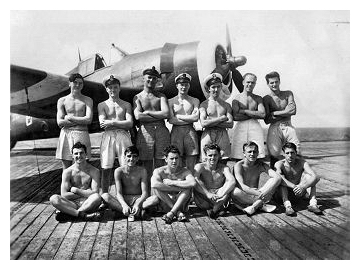 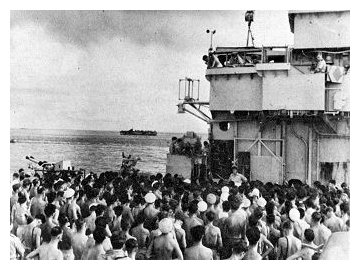 |
Hellcat maintainers pose with one of their aircraft
aboard
HMS EMPRESS and personnel gather on the flight deck for
a briefing about an upcoming operation. |
Squadron work ups and supporting roles: June - July 1945
At the end of May EMPRESS embarked squadrons for training in preparation for the upcoming operation COLLIE; she embarked 888
Sqn from Colombo Racecourse on the 31st for a short period of training, the squadron returned to Colombo on the 4th of June. Next the Hellcats of
896 Sqn embarked from
RNAS Tambaram and the Avengers of 845 Sqn from
RNAS Trincomalee on June 10th; 845 returned to Trincomalee on the 13th while
896 remained aboard until the 24th when they transferred to
AMEER.
Operation LIVERY: July 1945
EMPRESS was deployed with Force 63 for operation LIVERY on July 19th; the force comprised of the Battleship NELSON (Flag BS 3), Cruiser SUSSEX, CVEs EMPRESS (20
Hellcats of 896
Sqn, 1 Walrus of
1700 Sqn),
AMEER (24 Hellcats of 804 Sqn, 1 Walrus of
1700 Sqn), Destroyers ROTHERHAM (D11), RACEHORSE, RAIDER, and PALADIN to cover minesweeping operations carried out by HM Minesweepers PLUCKY, PINCHER, VESTAL RIFLEMAN and HM Indian Minesweepers PUNJAB and DECCAN off Phuket Island and conduct strikes on targets in northern Malaya.
The operation began on the 24th and was to last for three days: This was an intense flying period for the two CVEs, over a 3 day period Hellcats from both carriers flew over 150 sorties and destroyed more than 30 Japanese aircraft on the ground, together with trains and road transport in attacks on Kra Isthmus. On July 26th
AMEER was attacked by a Kamikaze, a single ‘Sonia’ attempted to dive onto
AMEER, it was hit and successfully deflected by fire from the ships' defensive armament, splashing into the sea some 500 yards out. Operation LIVERY was the last offensive operation carried out by the East Indies Fleet in WW2, two minesweepers were sunk during the operation: the remaining ships of Force 63 returned to Trincomalee on the 28th. Her new squadron had two aircraft put out of action, both were barrier crashes; on the 25th Lt. A. T. Hopton, RCNVR flying in JZ805 lost his arrester hook after striking the rounddown, and on the 27th Sub-Lt L R. J. Berry, RNVR in JX880 caught a late wire and the prop fouled the barrier.
Once back at Ceylon
896 Sqn disembarked to
RNAS Trincomalee on July 30th.
Operation CARSON: August 1945
EMPRESS sailed from Trincomalee on August 8th and re-embarked part of
896 Sqn: on the 10th she joined Force 61 for operation CARSON, a series of anti-shipping and airfield disruption strikes in the Penang and Medan areas to be carried out by Force 61, consisting of the Cruiser ROYALIST (Flag 21 ACS, Commodore G. N. Oliver, CB, DSO), CVEs
AMEER (20 Hellcats of 804 Sqn),
EMPEROR (20 Hellcats of 800 Sqn), EMPRESS (896 Hellcats), KHEDIVE (20
Hellcats of 808 Sqn), and
SHAH (845 Avengers), Destroyers TARTAR (D 10), PENN, VIGILANT, and VERULAM.
The Force sailed from Trincomalee on August 10th, the intention being to carry out the planned attacks on August 14th and 15th.
896 Sqn re-embarked once clear of the harbour. On August 11th the force was ordered to hold west of 90 degrees east and await further orders; the operation was eventually cancelled in light of the news of Japan’s announced willingness to accept the Allies’ surrender terms. The Force subsequently returned to Trincomalee, arriving on August 15th when the Station General Message “SUSPEND OFFENSIVE OPERATIONS AGAINST JAPANESE FORCES” was made to all ships and allied forces. Force 61 returned to Trincomalee.
EMPRESS continued flying operations throughout August, her squadron suffering two more accidents towards the end of the month; Sub-Lt G. N. Gordon, RNVR in JX724 landed with starboard drift with low wind speed and skidded into the walkway on the 23rd and Sub-Lt J D. W. Gunn, RNVR in JX706 burst a tyre landing on the 29th.
|
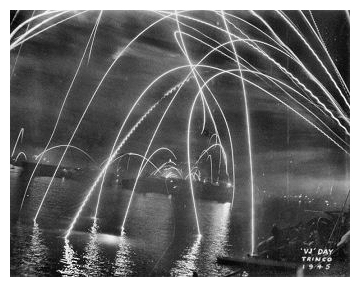 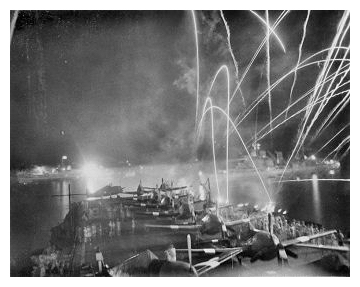 |
The view from the flight deck of
HMS EMPRESS on the night of August 15th 1945 as V-J Day
celebrations are underway. |
The reoccupation of Malaya, Operation ZIPPER: September 1945
After the Japanese surrender, plans to accept the surrender of Singapore were put into action; originally this was part of Operation ZIPPER but political constraints meant that no landing could take place until after the signing of the main surrender in Tokyo on September 2nd, 1945. The delays meant that all plans were now to change; thus, the reoccupation of Malaya would take place in three phases.
Phase one would be the recapture of Penang Island (modified Operation JURIST). Phase two would be the recapture of Singapore (Operation TIDERACE). Phase three would be the sea borne assault of North West Malaya in the Port Dickson, Port Swettenham area with landings near Morib with the 25th Indian Division and the 37th brigade of the 23rd Indian Division ( modified Operation ZIPPER), carried out as planned and rehearsed, but the covering air and sea bombardment had been cancelled.
The forces participating in these three operations were escorted by Force 61 which comprised of the Battleships NELSON (Flag Vice Admiral H.T.C. Walker, BS3), and RICHELIEU, the cruisers NIGERIA, CLEOPATRA, and CEYLON, with air cover from the 21st Aircraft Carrier Squadron, comprising of ROYALIST (Rear Admiral G. N. Oliver, CB, DSO, AC 21),
AMEER,
BEGUM,
EMPEROR, EMPRESS, HUNTER, KHEDIVE, PURSUER,
STALKER, and TRUMPETER (Ferrying RAF Spitfires) escorted by fifteen destroyers.
EMPRESS embarked replacement aircraft before sailing with the force which left Trincomalee on the 4th. The replenishment went badly as the first of the Hellcats to fly out to the ship had to be waved off by the DLCO and had to wait until the second one had landed safely; on his second attempt Sub Lt. R. W. George came in to high but ignored the DLCO signals and attempted a landing anyway. He cut his engine but passed over all the arrestor wires, and the barriers to drop onto several airframes in the forward aircraft park. More replacements had to be organised before she could proceed to join the task force.
The CVEs were to rendezvous with assault convoy JME1F on the 6th and provide air cover during passage of the Malacca Straight on the 8th and 9th,
BEGUM ran aground on leaving the harbour and was withdrawn from the operation. They were joined by HUNTER while at sea, she had sailed from Penang on the 7th. EMPRESS suffered another catastrophic catapult failure on the 8th and returned to Trincomalee. On the same day Mid I. C. McLean, RNVR ditched alongside EMPRESS in Hellcat JX679, he was picked up by the destroyer SAWNAREZ. EMPRESS arrived back off Trincomalee on the 13th flying off the aircraft of
896 Sqn for the last time to
RNAS Katukurunda.
|
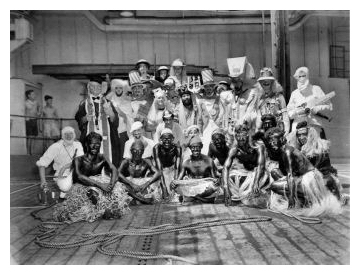 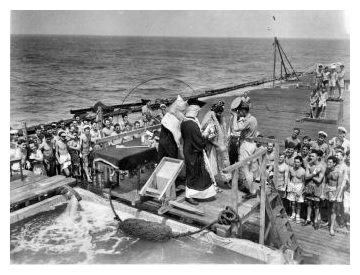 |
Members of the ship's company participate in the traditional 'Crossing the line'
ceremony as HMS EMPRESS passes the equator. |
Trooping voyage to Australia and New Zealand: October - November
1945
After a spell in Trincomalee under repair EMPRESS moved to Colombo on October 11th to embark passengers for a round trip voyage to Australia and New Zealand; on this trip EMPRESS was carrying commonwealth naval personnel home for demobilisation. She embarked (an unknown number) of passengers for Melbourne together with 370 ratings and 53 officers of the Royal New Zealand Navy, and 13 New Zealand soldiers for Wellington. She sailed from Colombo on October 17th.
EMPRESS arrived in Wellington on the morning of November 3rd having briefly called at Melbourne; once berthed at Aotea Quay she disembarked her passengers who were greeted by large crowds of relatives and spectators who lined the dockside. EMPRESS was one of the first warships to be open to the public after the war, and for several hours in the afternoon she was toured by eager visitors. The following day she was moved to another berth for minor repairs to be carried out before sailing on the return leg to Ceylon.
Passage to the UK: November27th - December 19th 1945
The ship arrived back at Colombo on November 23rd and began embarking more passengers and stores, this time in preparation for a voyage to the UK. Amongst her passengers were the aircrews and personnel of
896 Squadron; their aircraft were left at
RNAS Katukurunda, and the squadron was to disband on reaching the UK.
She left Colombo on November 27th and arrived in the Clyde on December 19th.
Disposal: return to US custody February 1946
Once all passengers and stores were unloaded EMPRESS was stood down from active service in preparation for her return to the US Navy. On completion of de-storing and equipment removal EMPRESS sailed for Norfolk, Virginia on January 6th 1946.
She arrived at Norfolk Navy Yard on January 20th and she was decommissioned as an RN ship on January 28th. CVE 38 was returned to the US Navy custody on February 4th 1946 and stricken for disposal on March 28th 1946. She was sold for breaking on June 21st 1946.
Content revised:
24 May 2022
Sources used in compiling this account:
Click here for a list of
Primary sources
Additional sources:
Wellham, J., (2003) 'With Naval Wings' Staplehurst,
Spellmount Publishers Ltd
Fold3.com various documents including;
Admiralty War Diaries
Norfolk Navy Yard War Diaries
Mew York Navy Yard War Diaries
Miscellaneous documents
|
Home
page |
go to the top
|
Comments (0)